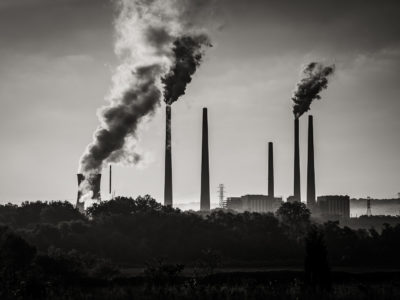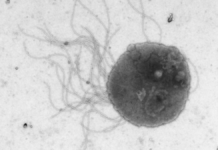A study released in Nature Biotechnology describes a method for carbon-negative manufacturing of chemicals at a large scale using microbes instead of petroleum and natural gas. The researchers used an autotrophic bacteria called acetogen (Clostridium autoethanogenum), which can live on one-carbon molecules— including the greenhouse gas CO2—and convert them into more complex organic molecules. After genetically engineering these bacteria to make them synthesize chemicals that they do not normally produce, the authors achieved carbon-negative production of acetone and isopropanol (IPA) at industrially relevant efficiency, selectivity, and scale.
Acetone is a commodity chemical used as an industrial solvent and as a precursor to acrylic glass and bisphenol A, among other uses. IPA is widely used in pharmaceuticals, cosmetics, and personal care products and as a solvent and cleaning agent. “Both acetone and IPA are manufactured today from petroleum and natural gas using energy-intensive cracking and reforming processes,” the scientific paper describes.
The team worked with C. autoethanogenum grown on steel mill waste gas. They documented the step-by-step process and achieved continuous production of acetone and IPA. “This would be impressive for an easily engineered organism but is even more impressive for an organism that is as difficult to engineer as a Clostridium,” the researchers pointed out.
Furthermore, they used the cradle-to-gate life-cycle assessment method for quantifying greenhouse gas emissions, from raw materials through final chemical manufacturing. The net carbon emissions were negative, even after factoring in the electricity and heat input needed to run the reactor where the industrial pilot-scale test was carried out. This is because the process captures carbon in steel mill waste gasses that would otherwise be flared and emitted to the atmosphere as CO2.
Researchers highlighted that acetogens can sequester into products of other underutilized fossil carbon sources and the process could be extended to other feedstocks. “Gasification of forest and agricultural residues also produces a mixture of CO, H2, and CO2 that could be directly used by C. autoethanogenum.”
According to the paper published this week, chemical manufacturing is the single largest industrial consumer of oil and gas and the third-highest CO2-emitting industrial sector, behind cement production and iron and steel mills.
“Creating a circular carbon or even net-negative-carbon industrial sector through novel synthetic biology approaches will not solve the climate crisis on its own, but it can tackle some of the most difficult-to-decarbonize parts of the global economy.” (Sic)
Chemicals from bacteria
Despite microbial systems being used in industry to create a diverse array of products—most of them high-value molecules such as flavors and fragrances, cosmetic additives, and pharmaceuticals—, only a small amount of commodity chemicals are produced microbially. Nowadays, the process involves microbes that ferment sugars and this method generates substantial amounts of CO2. “Microbial production of commodity chemicals using commonly available starch and sugar feedstocks tends to offer modest emissions savings over conventional petrochemical processes,” the team argued.
Meanwhile, autotrophic bacteria grow on simple carbon sources such as CO2, avoiding the downsides of sugar feedstocks. This molecule provides enough CO or H2 to supply the energy the microbes need to grow.
The researchers suggested that this progress offers hope that acetogens and other non-model organisms (organisms that have not been selected by the researchers either for historic reasons or because they are not easy to investigate) will have a meaningful role towards achieving a more sustainable future.
Reference
Scown, C. D., & Keasling, J. D. (2022). Sustainable manufacturing with synthetic biology. Nature Biotechnology. https://doi.org/10.1038/s41587-022-01248-8



